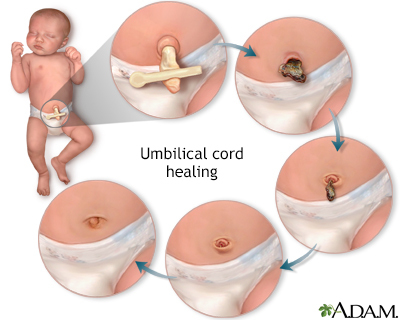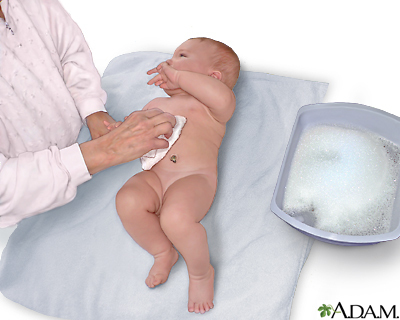Umbilical cord care in newborns
Alternative Names
Cord - umbilical; Neonatal care - umbilical cord
Information
When your baby is born the umbilical cord is cut and there is a stump left. The stump should dry and fall off by the time your baby is 5 to 15 days old. Keep the stump clean with gauze and water only. Sponge bathe the rest of your baby, as well. Do not put your baby in a tub of water until the stump has fallen off.
Let the stump fall off naturally. Do not try to pull it off, even if it is only hanging on by a thread.
Watch the umbilical cord stump for infection. This does not occur often. But if it does, the infection can spread quickly.
Signs of a local infection at the stump include:
- Foul-smelling, yellow drainage from the stump
- Redness, swelling, or tenderness of the skin around the stump
Be aware of signs of a more serious infection. Contact your baby's health care provider immediately if your baby has:
If the cord stump is pulled off too soon, it could start actively bleeding, meaning every time you wipe away a drop of blood, another drop appears. If the cord stump continues to bleed, call your baby's provider immediately.
Sometimes, instead of completely drying, the cord will form pink scar tissue called a granuloma. The granuloma drains a light-yellowish fluid. This will most often go away in about a week. If it does not, call your baby's provider.
If your baby's stump has not fallen off in 4 weeks (and more likely much sooner), call you baby's provider. There may be a problem with the baby's anatomy or immune system.
Gallery


References
Esper F. Postnatal bacterial infections. In: Martin RJ, Fanaroff AA, Walsh MC, eds. Fanaroff and Martin's Neonatal-Perinatal Medicine. 11th ed. Philadelphia, PA: Elsevier; 2020:chap 48.
Nathan AT. The umbilicus. In: Kliegman RM, St. Geme JW, Blum NJ, Shah SS, Tasker RC, Wilson KM, eds. Nelson Textbook of Pediatrics. 21st ed. Philadelphia, PA: Elsevier; 2020:chap 125.
Taylor JA, Wright JA, Woodrum D. Newborn nursery care. In: Gleason CA, Juul SE, eds. Avery's Diseases of the Newborn. 10th ed. Philadelphia, PA: Elsevier; 2018:chap 26.
Wesley SE, Allen E, Bartsch H. Care of the newborn. In: Rakel RE, Rakel DP, eds. Textbook of Family Medicine. 9th ed. Philadelphia, PA: Elsevier; 2016:chap 21.